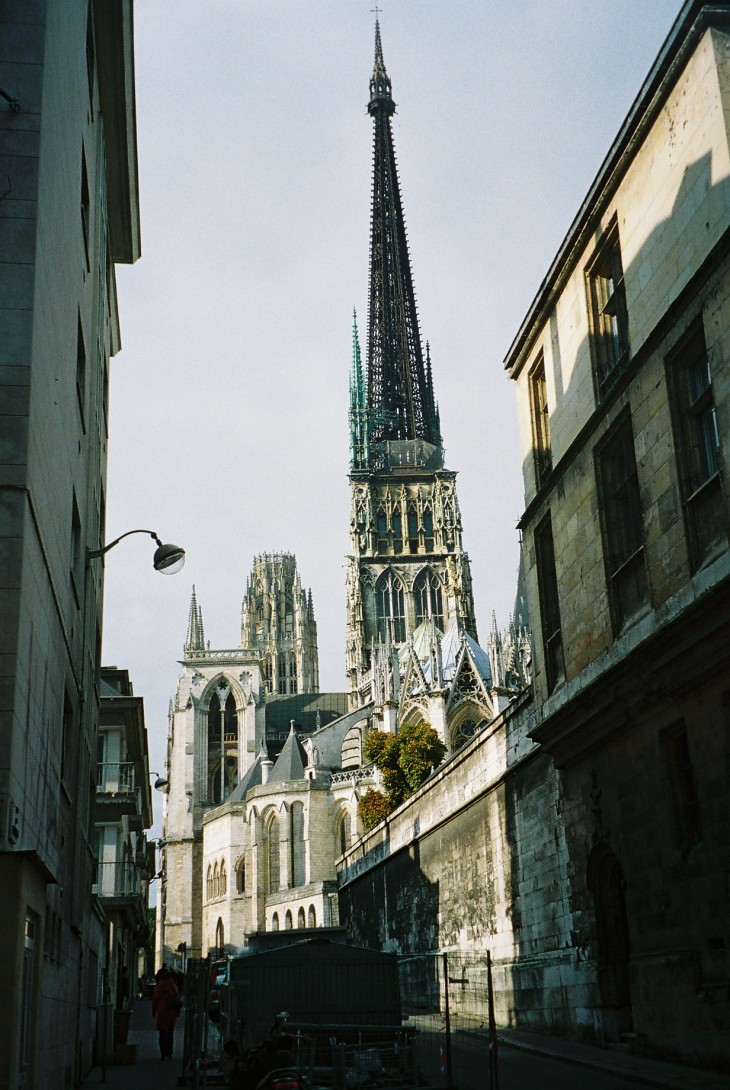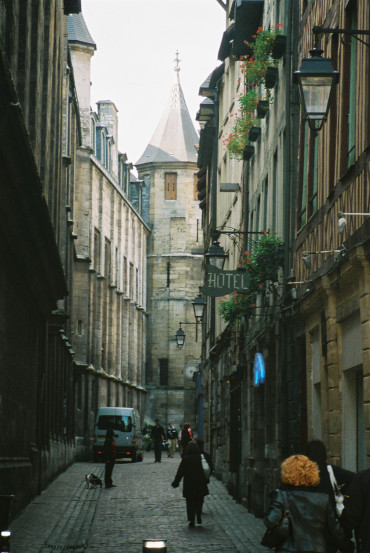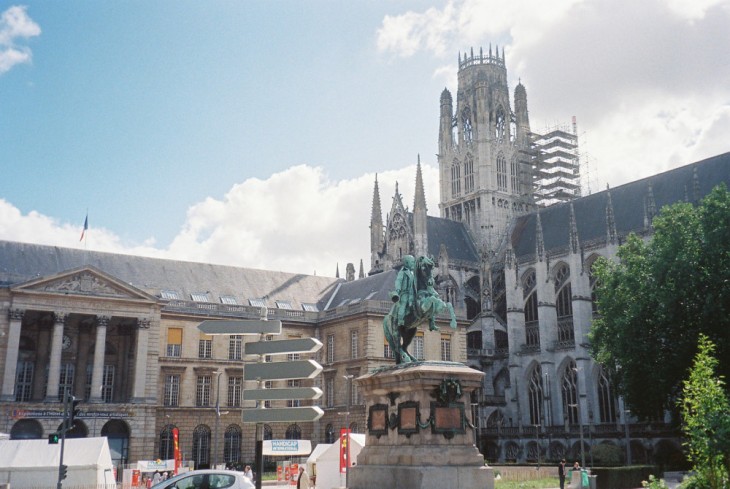One city I used to visit a lot when living in Versailles and now several years without been back. It is on my list for 2022 , the city of Rouen. Memorable family moments here over the years and even coming for lunch with the family! You can browse my many posts on Rouen in my blog. However, left somethings out that are worth keeping in my blog. Therefore, here are some curiosities of Rouen; hope you enjoy it as I.
One hugely picturesque quant street is the Rue Saint Romain. The Rue Saint-Romain runs alongside the Notre-Dame Cathedral through which you can enter through the portail des Libraires as well as the Portail de l’archevêché. It bears the name of Saint Romain, archbishop of Rouen in the 7C. Shoppers would love to browse the trendy clothing stores and small souvenir shops here, before stopping in cafes and restaurants for a relaxing break. Walkers, meanwhile, can stroll down this picturesque street, then visit the famous Notre Dame Cathedral and the Joan of Arc Museum. This pedestrian zone is a must-see in the city center.

A bit of history I like will tell us that in the 15C, it housed the “Escu de Voirre” sign, a workshop of the Barbe family of glass painters, the most important member of which was Guillaume, master glassmaker of the cathedral. It has bore the names of rue des Féronniers, rue de la Féronnerie, rue de la Féronnière, rue aux Ferons, rue de l’Archevêché then rue du Citoyen during the French revolution before taken its current name at the beginning of the 19C. Its picturesque character of the street made it a favorite subject for painters and engravers. The Rue Saint Romain was represented in particular by Thomas Colman Dibdin, Camille Pissarro, Eugène Boudin and Charles Pinet.

You have interesting buildings at No 70, Ferdinand Marrou’s workshop, circa 1902. The painter Henri Vignet lived there. No 74, one of the oldest and most picturesque houses in old Rouen, in the Gothic style with continuous fenestration. It dates from the 15C. its last restoration in 1902. And at No 84-88, neo-Norman ensemble produced in 1939.
An interesting architecturally and historical building in Rouen is its City/Town Hall serving since 1800 in the Place du Général-de-Gaulle , installed in the former dormitory of the monks of the Saint-Ouen Abbey (see post), The square is elliptical pedestrian with the representation of the signs of the zodiac and an underground car park,

A bit of history I like tell us that it is suppose City/Town Hall was initially established in the Halle aux Marchands. It is attested from 1191-1192, and was located near the Saint-Éloi Church. In 1220, the city hall was near the present rue du Gros-Horloge, on the urban stronghold of the Leicester family, located by the rue du Gros-Horloge, granted by Philippe-Auguste. It was to occupy the former Leicester mansion at the time. A belfry was built between 1220 and 1251, symbol of municipal power, In 1352, the town acquired, upwards of rue du Gros-Horloge, the property of the Du Chastel family. This set was roughly comprised between the rue aux Juifs, the rue du Gros-Horloge, the rue Massacre and the passage from the rue du Gros-Horloge to the rue aux Juifs. The part overlooking rue du Gros-Horloge was bought in 1490 from the heirs of the family. It is on this site that the Jacques Gabriel building will be built. At that time and until the French revolution, the city hall or town hall resided in the manor of Du Chastels. The clock was completed in 1389 , In 1410, two dials were placed on the porte Massacre, which linked the tower to the city hall. In 1527, the porte Massacre was demolished to be replaced by an arch surmounted by a pavilion, on which the dials were affixed. The building was completed in 1529.
The Gothic building, too small and threatening ruin in 1606, the city hall was rebuilt from June 1607 ; it was in a Florentine style in stone with bosses. The ground floor, formed by a series of arcades, was occupied by shops. In 1738, the city hall extended between rue du Gros-Horloge and rue aux Juifs, The building was sold in 1796 to various people ,while the facade on the rue du Gros-Horloge was restored in 1982. To solve the problem of space, a project of construction of a new city hall was decided in front of the place du Vieux-Marché, on the axis leading from the cathedral to the hospital. Work began in 1758, but was interrupted in 1765 for lack of money. There are still foundations in the rue Thomas-Corneille. The oak model, made in 1758 to present it to King Louis XV and obtain his approval, is on display at the Museum of Fine Arts.(see post)
Built from 1717 to 1721, the Hôtel de la Première Présidence housed the city hall offices from January 1791 to May 1800. Destroyed on August 25, 1944, today the portal to rue Saint-Lô remains of this hotel, which gives access to the terrace of the Palais. On May 30, 1800, the city hall was moved into the former Saint-Ouen abbey dormitories, which had been in disuse since November 1790. Abbey buildings were destroyed for the development of a square in front of the new city hall. In 1825, the building was transformed ; composed of two floors, two wings and a central peristyle, which constitutes on the ground floor the vestibule of honor, surmounted by a colonnaded box and crowned by a pediment, to which is affixed a clock. The facade on the garden side has not been modified. On August 15, 1865, the statue of Napoleon was inaugurated, As the city hall building burned down during the night of December 30 to 31, 1926, the archives from the 1800-1926 period were burned. Only the marriage hall and that of the municipal council were spared by the flames. Many paintings and statues including that of Louis XV were saved from damage., and the building was rebuilt in 1928. In June 1940, the Feldkommandantur 517 occupied the city hall. The bombings during WWII did not spare the new construction. On April 19, 1944, the south staircase was completely destroyed by a bomb, It was rebuilt.
The City of Rouen on its heritage: https://rouen.fr/tourisme
The Rouen tourist office on its heritage : https://en.rouentourisme.com/sites-monuments/
There you go folks, another dandy town in my belle France. Rouen is in the Seine Maritime dept 76 of the region of Normandie. It is worth a detour and walks these streets and monuments, love it!! Hope you enjoy it as I
And remember, happy travels, good health, and many cheers to all!!!

Looks fabulous. Thanks for the tour.
LikeLiked by 1 person
Thanks for stopping by Cheers
LikeLike